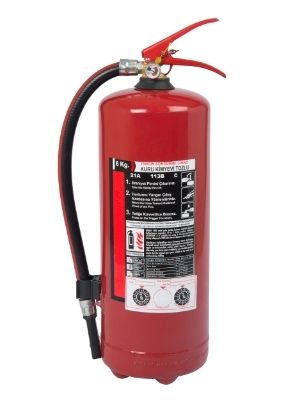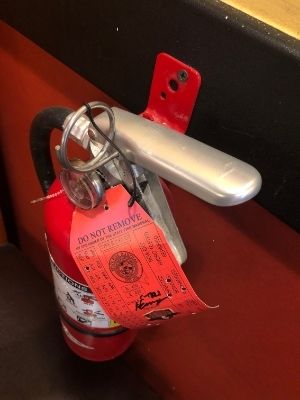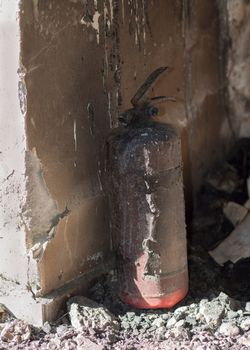If your home is like many in the United States, then it has a fire extinguisher. Maybe the extinguisher was already there when you moved in, or perhaps you recently furnished your home with one. You haven’t had to use it, thank goodness, but if you ever did, would it work? Can fire extinguishers expire?

Fire extinguishers can expire. Dry chemicals within the extinguisher last anywhere from six to 12 years. Your fire extinguisher might still work after that, but not as well. That’s why it’s a good idea to buy a new extinguisher every five to 15 years.
In this article, we’ll talk further about whether fire extinguishers expire and how often to replace yours. We’ll also share some signs that you need a new extinguisher, so make sure you keep reading!
Table of Contents
Why Do Fire Extinguishers Expire?
A fire extinguisher is not like a box of crackers or a jar of peanut butter in that it has a clear expiration date printed somewhere on it. That would be convenient, but it’s just not how extinguishers work.
At best, you might be able to deduce the age of the fire extinguisher through the manufacturing label, which is something we’ll talk more about in the next section.
Even if your fire extinguisher has no manufacturing date, that doesn’t mean it lasts forever. Fire extinguishers can expire. To help you understand how it happens, let’s explain briefly how fire extinguishers work.
Fire extinguishers are full of a dry chemical that’s usually powder-like. The powder can eliminate the facets of the fire triangle or a combustion triangle. Fire triangles encompass three ingredients, so to speak, that can spark a fire. Those are oxygen, heat, and fuel.
The dry chemicals tamp down all three. Here are some dry chemicals that are added to fire extinguishers:
- PYROKYL or MET-L-KYL, a sodium bicarbonate variation
- Foam-compatible, which is a dry chemical with sodium bicarbonate
- Potassium chloride, aka Super-K
- Urea Complex and potassium bicarbonate, referred to as Monnex, for class B and C fires
- Potassium bicarbonate with Purple-K as a constituent, which can also combat class B and C fires
- Sodium bicarbonate, which too is for class B and C fires
- Monoammonium phosphate or ABC dry chemical, as it can put out class A fires too
If class D fires are a risk–which are fires started by combustible metals–then a different type of dry powder will be used in a fire extinguisher. Here’s that list:
- Ternary eutectic chloride or T.E.C, which includes barium chloride, potassium, and sodium
- Sodium-carbonate-based powder or Na-X for stainless steel equipment and piping in which sodium chloride would be too damaging
- Graphite-based powder such as Chubby Pyromet, Lith-X, G-1, and G-Plus with dry graphite
- Copper-based powder, including Copper Powder Navy 125S
- Sodium chloride power such as Pyrene Pryomet, M28, Met-L-X, and Super-D
If not a dry chemical, then fire extinguishers will include foam. The foam comes out one of two ways: non-aspirated or aspirated. Aspirated foam refers to that which is added to a branch pipe and then combined with air to expand it.
The types of foam used in fire extinguishers include:
- Cold Fire, a cooling wetting agent
- FireAde, which can emulsify a liquid as it burns
- Arctic Fire, which also emulsifies heated materials
- Compressed air foam system or CAFS
- Film-forming fluoroprotein or FFFP with animal byproduct proteins
- Alcohol-resistant aqueous film-forming foams or AR-AFFF
- Aqueous film-forming foam or AFFF, which is for class A and B fires
Some fire extinguishers use halons, others water additives such as antifreeze or wetting agents, and more still will use water, from mist to air-pressurized water to pump-type water.

The products in fire extinguishers, from foams to dry powder, are not infinite. As we touched on in the intro, dry powder lasts for six to 12 years. Foam in fire extinguishers has a lifespan of five years or more.
These products become less effective with time. Your fire extinguisher might work, at least technically, but would it combat fires as well as a brand new fire extinguisher? The answer, quite clearly, is no.
Understanding the Manufacturing Date on Fire Extinguishers
We had mentioned in the last section that some fire extinguishers have information on them that displays the manufacturing date. This date–if your fire extinguisher has one–can clue you in on whether your fire extinguisher is two years old or 20.
If you moved into a house or apartment that already has a fire extinguisher, then the manufacturing date is a lifesaver.
A fire extinguisher can include lots of information, so you have to know what you’re looking for and where. Where the manufacturing date will be printed on the fire extinguisher can vary from one fire extinguisher brand to another.
Some fire extinguishers have printed labels or tags with this information. Other brands print the manufacturing date right on the extinguisher, where it’s usually embossed into the metal. You might have to move the extinguisher’s plastic boot or lift the plastic ring on the extinguisher’s neck to see the manufacturing date.
Once you find the manufacturing date, it’s not going to be displayed like month, date, and year (or date, month, year for UK readers). Instead, your manufacturing date might look something like this: I.E.1205322062.
What does all that mean? Well, 1205 refers to a 24-hour clock. The 322 is the month and date, which in this case, would be November 18th. The 06 is the year, so 2006, then the 2 refers to the manufactured assembly line.
How Often Should You Replace Your Fire Extinguisher?
Continuing the example from above, if your fire extinguisher was indeed produced in November 2006 and it’s 2021 now, can you continue keeping the extinguisher, or is it time to think about getting a replacement?
It’s a good idea to replace your fire extinguishers every 5 to 10 years. Extinguishers are relatively inexpensive and can save life and property.
The average lifespan of a fire extinguisher is between five and 15 years. Sometimes the estimates are even shorter, only 10 or 12 years. In the case of a fire extinguisher from 2006, that’s 15 years ago.
Since 15 years is the outer estimate for when to replace a fire extinguisher, we would say that yes, you need a new fire extinguisher, stat!
How to Know When It’s Time for a New Fire Extinguisher
The age of your fire extinguisher is not the only indication that it might be time to get rid of yours. Here are some other signs to be on the lookout for now and in the future.
The Fire Extinguisher Is Now Obsolete
This doesn’t happen more than necessary, but when the National Fire Protection Association or NFPA deems that a fire extinguisher is obsolete, then it’s obsolete, no questions asked. As of this writing, if your fire extinguisher was made before 1971, 1976, or 1984, then it’s obsolete.
The Fire Extinguisher Is Externally Damaged
All sorts of damage can occur to a fire extinguisher that necessitates having to replace it. If the extinguisher is rusted anywhere, then it’s no good. Dents and dings are also bad signs.

Check the pressure gauge too. Once the pressure exceeds its operating range, you can’t rely on the fire extinguisher moving forward.
The Fire Extinguisher Can’t Pass a Hydrostatic Test
You should put your fire extinguisher through a hydrostatic test every now and again. This test determines how well the extinguisher can maintain pressure. Not only is the strength of the fire extinguisher called into question, but hydrostatic testing can confirm whether your extinguisher is leaking.
A hydrostatic test begins with a visual inspection for signs of damage. Next, you want to discharge the extinguisher, first taking out the hose and adding a recharge or hydrotest adapter. Then it’s time to test the pressure of the fire extinguisher.
You yourself won’t perform a hydrostatic test on your fire extinguisher; you’ll have to hire a professional to do it. If your fire extinguisher fails the hydrostatic test, then you cannot continue using it.
Fire extinguishers can expire, as you should replace them every five to 15 years or so. The dry chemicals in the extinguisher only last for around six or 12 years, so the efficacy of your extinguisher depletes more and more the longer you have it.
Even if your fire extinguisher isn’t all that old, if it fails hydrostatic testing or it’s externally damaged, then it’s not safe to keep the extinguisher in your home. If you ever do need it, the extinguisher might not be able to control a fire as it should.